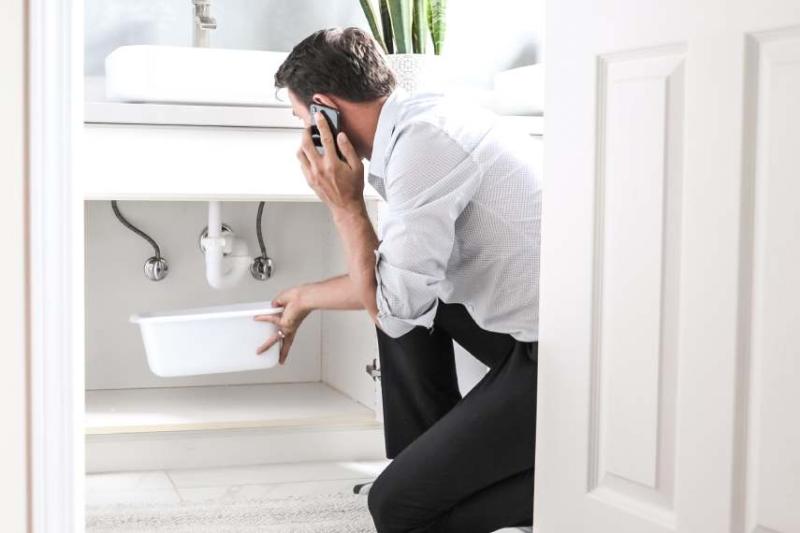
Escape of water is a common issue, and you’ll usually need to contact your insurer to fix it.
Below, we explain what escape of water means, how to spot it, what we can cover and how to claim for it.
What’s escape of water?
Escape of water is usually a part of your buildings and contents insurance.
It means water leaking from the mains supply. It doesn’t protect against all types of water damage. It only covers water escaping from a:
- domestic appliance
- fixed water tank
- fixed central-heating system
- water pipe
The most common cause of escape of water is burst pipes, which usually happen in freezing weather.
Escape of water can also be caused by:
- faulty or failed grout or sealant
- water escaping from pipes above ground
In these scenarios, escape of water claims aren’t typically covered.
What to do after a water leak
Here's our guide on what you need to do after you've noticed you've got a leak.
Immediately after noticing it
You should only take the below steps if it’s safe to do so. For example, if turning off the mains electricity involves standing in water, please contact an electrician.
You should:
- turn off the main water supply via the stopcock
- drain the system by running the cold tap
- turn off the power, and avoid electrical appliances
- open doors and windows
- contact a professional to fix the issue
We recommend taking photos too, if you’re claiming.
Home Emergency customers
If you're a Home Emergency or Home Emergency Extra customer, you can visit our make a claim page or register one in MyAccount.
Home Emergency cover is for claims that:
- are reported within 48 hours of discovery
- are for emergencies that are a total failure, meaning total loss of service
- have uncontainable leaks
- are for temporary repairs up to £500 (Home Emergency cover), or £1,000 (Home Emergency Extra cover)
Before calling, make sure you check your policy details and cover limits on MyAccount.
In the days after
- Dry out – give walls, floors and furniture enough space for air to circulate.
- Clean – you’ll need to wash and disinfect every surface in your home to prevent mould, including floors, walls and shelves when dry.
- Strip out – remove affected furniture, fixtures and plastering repair – walls need to be fully dry before they can be replastered and redecorated.
Your property might only need cleaning and drying out for smaller escape of water damage.
How to keep your home leak-free
You can take some proactive measures to lower the chance of getting a leak:
- use a stud finder if you’re doing DIY to help you find any hidden pipes
- keep your downspouts and gutters clean
- wrap or ‘lag’ your pipes to prevent them from freezing
- know where your stopcock is and how to switch it on and off
- keep the sealant (white silicone) around the shower and bath well maintained
- plan ahead if you’re leaving your home unoccupied
If you’re leaving your home unoccupied, here are some tips to protect your home:
- keep your central heating on low so your pipes don't freeze
- leave your loft hatch open
- turn off your water supply and drain the system
- check your policy information for unoccupied property conditions
What we cover
All three of our Home Insurance tiers cover escape of water, but only for water escaping from a:
- domestic appliance
- fixed water tank
- fixed central-heating system
- water pipe
However, different parts of your policy cover you for different types of damage and maintenance, so read it carefully.
For example, products like trace and access cover will cover you for sourcing the leak, while Home Emergency cover will arrange and pay for a tradesperson to make a temporary repair of the damage once the source is known.
Read your policy for more information.
What escape of water claims we don’t cover
We won’t cover you for:
- damage to any drains and pipes
- overflowing taps, as a result of any taps being left on
- faulty, failed or inadequate grout or sealant
- water escaping from external pipes that are above ground
- loss or damage caused to solid floors by infill materials settling, swelling or shrinking due to the escape of water
- loss or damage caused by subsidence, heave or landslip resulting from the escape of water
- loss or damage caused while your home is unoccupied
How to claim for escape of water damage
If you have Home Emergency Cover, visit our Make a Claim page or register your claim in MyAccount.
If you don’t, open a claim with your insurer – most will prefer you to contact them first.
You can open a claim with us in three ways:
- through MyAccount
- through our make a claim page
- calling us on 0333 220 2035
We recommend using MyAccount.


